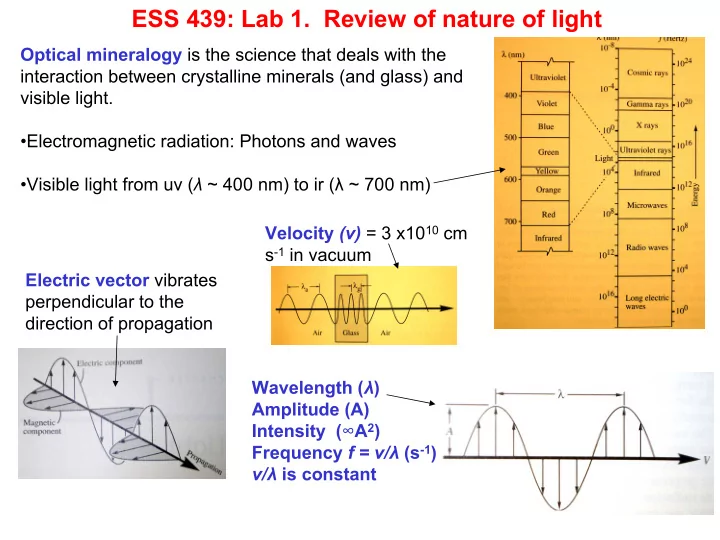

ESS 439: Lab 1. Review of nature of light Optical mineralogy is the science that deals with the interaction between crystalline minerals (and glass) and visible light. •Electromagnetic radiation: Photons and waves •Visible light from uv ( λ ~ 400 nm) to ir ( λ ~ 700 nm) Velocity (v) = 3 x10 10 cm s -1 in vacuum Electric vector vibrates perpendicular to the direction of propagation Wavelength ( λ ) Amplitude (A) Intensity ( ∞ A 2 ) Frequency f = v/ λ (s -1 ) v/ λ is constant
Wave front: surface that connects similar points on adjacent waves Wave normal: Line ┴ wave front Ray: direction of propagation Isotropic medium: velocity of light is same in all directions (wave normal = ray direction), e.g., glass and isometric crystals) Anisotropic medium: Velocity is different in different directions (wave normal and ray direction are not parallel), e.g., all non- isometric crystals)
Light waves (cont.) (1) Interference of waves Retardation ( ∆ ) ∆ = i λ In phase when i is an integer and Out of phase when i is a fraction When i = ½ complete cancellation (2) Resolution of waves R A B (3) Color: Monochromatic light (single wavelength), e.g., Na vapor λ = 589 nm Polychromatic (aka. “white”) light: multiple wavelengths
Light waves (cont.) Reflection θ 1 θ 2 Refraction: “bending” Snell’s law: of light as it passes from one medium to another— Sin θ 1 /sin θ 2 = n 2 /n 1 function of differences in refractive index (n) n = v vac /v med n ≥ 1.0 In air, n = 1.0003 Minerals: n ranges from ~1.4 to ~2.0
Light waves (cont) Critical angle and internal reflection r air sin r = (n i /n r ) sin i med i i i when r = 90º sin r = 1 Critical angle: when (n i /n r ) sin i = 1 Absorption and color Dispersion 1 Clear glass Recall: v ∞ λ Red glass I 0 /I T n ∞ 1/ λ n ∞ 1/v Dark glass 0 400 800 λ (nm) n D is the value reported in tables Lambert’s law: I 0 /I T = e -kt where I T = int. of transmitted light I 0 = int. of incident light t = thickness k = absorption coefficient
Light Waves (cont.) Polarization of light In routine optical mineralogy we use polychromatic (white) light provided by a tungsten lamp with a blue filter. On occasion, for precise determination of refractive index (n) we use monochromatic light provided by a sodium vapor lamp ( λ = 589 nm). Light is polarized, i.e., it is constrained to vibrate in a single direction, in our case an East-West direction. Referred to as “ plane polarized light ” and the direction of vibration of the polarized light is called the PRIVILEGED DIRECTION Polarization may be produced by: 1) selective absorption using polaroid film 2) Double refraction using a Nicol prism made from calcite
Polarizing microscope
Recommend
More recommend